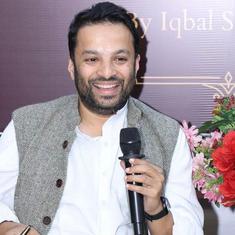As the flower-bedecked train trundled into Platform Number 9 in Mumbai’s Borivali station on Christmas morning a loud cheer went up. Hundreds of people had turned up to witness the landmark event: 164 years after the city’s – and India’s – first train was inaugurated, Mumbai’s overstuffed railway system kicked off its first air-conditioned service at 10.32 am on Monday.
In a city of faded residents, the debut run of the air-conditioned train elicited uncharacteristic enthusiasm. Scores of people clambered into the cool confines of the compartments flashing broad smiles and clicking selfies. They inspected the automatic doors, tapped at the thick glass windows and marvelled at the fact that commuters could walk from one compartment to the next through vestibules between the carriages, just like in long-distance trains.
“...Travelling in the train on the very first day is exciting,” said Sunil Bhandari, a chartered accountant as he commenced his journey southwards to Churchgate station. Added Prachi Salunke, an engineer: “This feels really good.”

It’s clear that the 7.5 million commuters in this city of 20 million who ride the local train every working day could do with some respite. At peak hour, 4,500 Mumbaikars find themselves jammed into trains designed to carry 1,700 passengers. This means that an average of 15 commuters are packed into each square metre of floor space. For passengers who find themselves in this “super-dense-crush-load”, as the authorities refer to it, ventilation is limited – and it is especially uncomfortable during sweaty summers.
It isn’t just the compartments that are congested. The railway stations are too. On September 29, a stampede on a narrow pedestrian bridge at Elphinstone Road station claimed 23 lives and left 39 people injured.
As a consequence of these conditions, many affluent Mumbai residents have stopped riding the trains and taken to the road. This has afforded them a little more comfort – but not much more speed. The city now has an estimated 3 million vehicles on its 2,000 km of roads, a growth of 50% over the past five years. With 1,500 vehicles packed into each km of road, the city often seems like one continuous traffic jam. At peak time, traffic crawls at merely 20 kmph.
The railway authorities hope that the combination of speed and comfort at a fraction of the cost of a road trip will persuade commuters to ride the new air-conditioned trains. While it could take car drivers approximately two hours to travel from the northern suburb of Borivali to the business district of Churchgate in the south, the trip on a fast train making limited stops takes only 50 minutes.
That, agreed some of the commuters on the inaugural run on Monday, was a great part of the appeal. “There is a lot of leg space, the AC is good and the time taken from Borvali to Churchgate is less than an hour for a fare of Rs 165,” said Bhandari, the charted accountant. He said that the same commute in an airconditioned taxi would cost Rs 500 and take much longer.

Heavy on the pocket
Starting from January 1, the Western Railways will run 12 AC services every work day. Services will not run on weekends, to allow time for maintenace.
For the first six months, the ticket prices will be 1.2 times the first-class fare. A one-way ticket from Churchgate to Virar will cost Rs 205, while a one-way ticket from Borivali to Churchgate will be priced at costs Rs 165.
This, commuters predicted, will be a winner in a city where time is money. “In Mumbai, people don’t have ego,” explained Bhandari. “Even a crorepati will travel by train because it takes less time. Here people don’t bother whether it is a Mercedes or BMW or a train. They want to reach places fast and they want to reach work fast and do not want to waste time.”
Anita Kohli, a Railway Protection Force constable assigned to the train, was confident that the service will be successful. “Not everyone will be able to afford the ticket, but sometimes if the middle class wants to travel, they can,” she said. “That way there will be less crowd in the train.”
The pricing, commuters concurred, is what will determine how frequently they use the service. “I travel from Central Mumbai to Western Mumbai everyday,” said mechanic Sameer Kumar. “It might become a little costly for us. This train might not be for me.”
Datta Patankar, a middle-aged businessman, agreed with Kumar. “The train is very nice, but it is for the rich and not for the middle-class,” Patankar said. “This train should be available for everybody. It is difficult to travel everyday, but I will try to take the train once in a while with family.”

Financial analyst Nirav Khala was also critical of the prices. He drew comparisons between fares on the Mumbai metro and the air-conditioned train “The metro rail from Versova to Ghatkopar is 11.5 km and the fare is Rs 40,” said Khala. “But the metro was built by a private and public partnership. The AC local on the other hand is completely managed by the government. For 10 km, the ticket rate is Rs 65 plus. Being a government service, it should be cheaper than the metro.”
He noted: “Mass transport is meant to be in such a way that a lot of people are able to use it. I will not travel in the train with these prices.”
Football coach Maruthi Chauhan echoed this view. “We should have trains of this standard for the working class,” he said. “Modiji roams out of country and tries to brings ideas to Mumbai. We must be able to work something out and give the services to all.”











